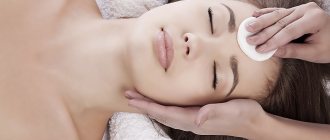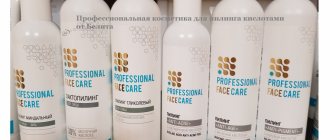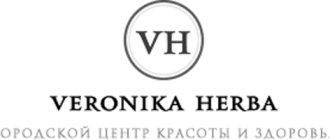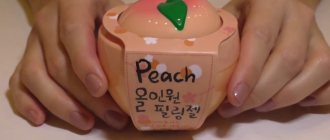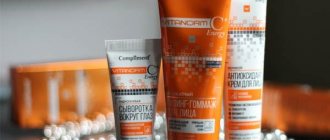Chemical peeling is iatrogenic damage to certain layers of the epidermis and/or dermis.
In response to damage, a huge amount of pro-inflammatory mediators, growth factors, and biologically active substances are released, which leads to the activation of protective regenerative mechanisms, an increase in the metabolic and mitotic activity of basal keratinocytes and fibroblasts. The expected effects of the chemical peeling procedure are improvement of the appearance of the skin: color, smoothing of the skin profile, improvement of micro- and macrorelief, activation of reparative processes, increased synthesis of epidermal lipids and extracellular structures of the dermal matrix. The effect depends more on the depth of skin damage and less on the chemical preparation. The stimulating effect of chemical peeling is indirect. This is the skin's reaction to inflammation that develops as a result of skin damage.
Classification
- Superficial peeling (within the stratum corneum) minimal inflammatory reaction, m/painful, the safest. AHA, aβ-complexes, phytic, Jaisner, 1-15% TCA.
- Median (within the Malpighian layer). Medium peeling is accompanied by necrosis of the Malpighian layer, with the development of a pronounced inflammatory reaction (hyperemia, edema) and severe peeling; the rehabilitation period is 7-14 days. Allows you to change (smooth) micro- and macrorelief. Recommended for the correction of superficial wrinkles, enlarged pores, post-acne, and stretch marks. 15-25% TCA, combined TCA + enzyme (papain), Blue peel, Krulig peeling, phenol.
- Deep (with damage to the papillary dermis)
The only type of peeling that allows you to correct wrinkles, a high risk of scarring, rehabilitation up to 1.5 years. 25-50% TCA, phenol up to 40% - the “gold standard” of peeling. The most effective, the most toxic. It has a selective cytotoxic effect on melanocytes - recommended for the correction of hyperpigmentation.
Types of peelings for facial skin
An experienced specialist will help you determine which type of facial peel to choose. The effect of the procedure depends on the depth of exposure of the drugs. The cosmetologist will assess the condition of the skin, the specifics of existing problems and recommend the most suitable option.
Name and description of the main types of facial peeling:
- Superficial peeling. The procedure involves cleaning only the upper layers of the epidermis, without affecting the living layers. The process of superficial peeling removes dead cells. There are practically no contraindications to this procedure, it is painless and does not cause complications.
- Medium peeling. Involves cleaning the entire skin layer. During the session, drugs penetrate deeper into the epidermis, which has a beneficial effect on metabolic processes. Medium peeling is performed only by a professional cosmetologist. After such manipulations, the skin needs intensive restoration.
This type of facial peeling in cosmetology is intended for rejuvenation. It helps eliminate large areas of pigmentation, reduce deep wrinkles, and get rid of old spots. After the procedure, minor burns and red marks remain, so the recovery period can be 3–4 days.
- Deep peeling. Quite a complicated procedure. All manipulations are performed only in a hospital setting with mandatory pain relief. In the process, all layers of the epidermis are destroyed. Tissues begin to regenerate from the remaining fragments.
Deep peeling (laser and chemical) is an aggressive cleaning method. This procedure immediately rejuvenates by 8–10 years, due to the almost complete burning of old skin and its replacement with new one.
The most common anti-aging procedure is medium peeling.
In order to refresh the skin, superficial cleaning is performed at least 2 times a month. To eliminate defects and prevent early age-related changes, medium peeling is performed twice a year.
Indications for deep peeling must be very serious.
There are the following types of peelings for cleansing the skin:
- chemical;
- mechanical;
- ultrasonic;
- laser.
Let's look at each type in more detail.
Superficial chemical peeling AHA
When talking about superficial chemical peeling, we primarily mean peeling with AHA, or fruit acids.
The first mention of cutaneous use of AHA dates back to 1974. Van Scotch and Yu, studying the effect of various drugs for ichthyosis, found that glycolic acid is able to control the processes of keratinization of the epidermis, weakening the adhesion between corneocytes. Subsequently, the therapeutic effectiveness of ANA was established for all forms of hyperkeratosis.
The AHA group includes: glycolic, lactic, apple, tartaric, lemon
Chemical and laser peels - what are they?
Chemical peeling involves applying solutions with a certain acidity to superficially exfoliate the skin. It is recommended to do either a superficial or a mid-level chemical peel, as the deep type of chemical peel can be very damaging to the skin and the recovery period is very long - the skin may not recover optimally.
Laser peeling is exposure to a light beam aimed at evaporating water. In this case, exfoliation occurs because skin cells are sloughed off by removing water from them.
Indications for use
Biological aging of the skin. Almost all types of peelings are used to correct signs of aging. The choice of one procedure or another is determined primarily by the severity of cosmetic defects. ANA peeling optimal age 23-30 years (prevention of aging), no correction of age-related changes. Number of procedures 4-6, ANA concentration 50-70% Additional components: antioxidants
Photoaging is changes in the skin under the influence of UV rays. 50-70% ANA, number of sessions 8. The most promising is the combination of ANA with antioxidants and whitening agents.
Pigmentation -
- dyschromia - 70% ANA, amount 8. Optimally αβ-complexes
- chloasma, hyperpigmentation - it is recommended to use AHA up to 50%, as inflammation can cause increased pigmentation. Pre-peel preparation is required to reduce the risk of increased hyperpigmentation, includes the use of phytic acid 3-10%, combined preparations of glycolic acid + kojic acid, ascorbic acid, glabridin, antioxidants that reduce inflammation are recommended, and the use of UV filters is mandatory. Number of sessions 8.
- Comedonal, papulopustular form of acne. Initially, the use of ANA for acne vulgaris was limited exclusively to the treatment of post-eruptive hyperpigmentation and scarring. This was the only method for correcting secondary skin changes in this disease, which is possible even against the background of unresolved inflammatory elements. Subsequent clinical observations showed that the use of this group of drugs significantly accelerated the relief of the inflammatory process and extended the time of remission
What is the purpose of chemical peels (indications):
- improvement of skin condition (its texture and color);
- skin rejuvenation;
- with skin laxity and loss of elasticity;
- brightening, smoothing, improving oxygenation of the skin, increasing its hydration and elasticity;
- reduction or elimination of wrinkles and other signs of skin aging;
- elimination of signs of skin photoaging;
- reduction of wrinkles around the nose and under the eyes;
- whitening or removal of freckles, age spots, most often occurring during pregnancy or while taking birth control pills, consequences of inflammatory processes;
- reduction or elimination of small scars, for example, from acne or traumatic ones;
- in the treatment of certain types of acne, comedones;
- with seborrheic dermatitis - oily skin, enlarged pores;
- as a peeling - the components of chemical peeling penetrate into the skin, moisturize it, stimulate fibroblasts to action (production of collagen, elastin), and repeating the procedure several times allows you to get rid of skin “defects” forever;
- smoothing and reducing the visibility of stretch marks;
- with keratinization, dry skin;
Medium chemical peels
TCA (15-25%) is a keratolytic, causing protein coagulation. Non-toxic substance.
When applied to the skin, TCA causes the formation of a frost effect. Depending on the depth of necrosis, the following types of frost effect are distinguished:
- Pink frost: “pointed” - throughout the entire depth of the stratum corneum; “clouds” - granular layer
- White (milky): translucent film - the border of the granular and spinous layer
- White deaf, compact: up to the basement membrane, dermal papillae
- Solid white with a yellowish/greenish tint: up to the reticular layer (there will be a scar in this place).
Classification of peelings by depth of impact
Based on the depth of impact, the following types of peelings are distinguished:
- Surface. Acts at the level of the stratum corneum of the epidermis. Promotes activation of cellular renewal, has moisturizing, antiseptic, anti-inflammatory effects. Tightens pores and normalizes sebum production.
- Median. It is carried out using more powerful compounds that dissolve skin cells down to the papillary layer. Medium exfoliation eliminates signs of aging, age spots, scars. It is used in complex acne therapy.
- Deep. It is carried out using aggressive compounds that promote skin renewal. Indicated to eliminate pronounced age-related changes - sagging, pigmentation, wrinkles, scars. Due to the fact that the compositions act quite deeply, the procedure is carried out under anesthesia, and rehabilitation takes about 4-6 weeks, but its effect persists for several years.
This classification does not always reflect the actual depth of penetration of the composition. What some experts call a medium peel, others consider deep. When treating acne vulgaris*, it is important to consider which layers of the skin are affected by the substance in order to achieve the desired effect and not harm the patient.
The penetration depth of chemicals depends on the following factors63:
- acid concentration;
- number of layers applied;
- thickness and type (oily, dry, normal) of skin;
- the tool with which the composition is applied (for example, a brush or napkin);
- the pressure exerted on the skin when applied
Aesthetic medicine specialist Philippe Despres proposed to distinguish 7 levels of peeling penetration63:
- Exfoliation. It acts superficially, which is expressed in the detachment of the stratum corneum. Provides a high level of skin cleansing and increases hydration.
- Intraepidermal. The exfoliating composition acts on the epidermis, as a result, keratinocytes produce more tumor necrosis factor alpha, stimulating the basal layer to renew itself. Fibroblasts begin to synthesize more intercellular matrix. Such peelings help solve the problems of melasma and improve keratinization.
- Basal layer. Promotes the removal of cells of the stratum corneum. The procedure is carried out to achieve a rejuvenating effect, eliminate small wrinkles, remove epidermal melanoma, combat acne vulgaris and keratoses.
- Grenz zone. Acids reach the papillary dermis, removing abnormal cells from the epidermis, keratinocytes loaded with melanocytes and melanin. The procedure stimulates the retention of elastin and collagen in the border zone of the basal layer.
- Papillary dermis. Due to the penetration of acids into the dermis, coagulation of proteins occurs, the so-called epidermal sliding effect appears. Using this procedure, you can fight solar keratoses, deep wrinkles, freckles, and lentigines. This peeling is carried out at the border between safe and dangerous depths.
- Peeling of the reticular dermis (superficial).
- Complete peeling of the reticular dermis. Carrying out such procedures allows you to solve even complex problems with pigmentation disorders, remove wrinkles, and tighten the skin. They are not recommended for patients with oily, thick skin, as acids have a bad effect on them. This type of therapy is very aggressive, so it must be carried out exclusively by a qualified and experienced specialist who is well versed in acid application techniques, types of compounds and their properties. The patient is required to comply with post-peeling care. An error during this procedure can lead to the formation of scars and post-inflammatory hyperpigmentation. But the danger of this procedure does not exclude the possibility of using reticular peeling due to its value for aesthetic medicine.
This division more accurately reflects the properties of peelings. Although peelings have a beneficial effect on the skin, improving its condition, they cannot replace drug treatment for acne, but are often used in combination with it.
Contraindications
Absolute:
- Dermatoses in the acute stage (especially herpes infection)
- IV,V,VI skin phototype
- Tendency to form hypertrophic and keloid scars
- Rehabilitation period after other cosmetic procedures (Botox - 14 days, microimplants - 1 week, laser resurfacing, dermabrasion - no earlier than 1 year)
- Pregnancy, nursing (painful procedure)
- Mentally labile patients.
- Thin, sensitive skin with reduced regeneration
Relative: nevi, rosacea, hypertrichosis, spring-summer period
Expected skin reactions occurring immediately after a chemical peel (1-14 days):
- Edema. Most often, swelling and pastiness develop with deep peels. With superficial peeling, swelling is moderate or absent. It develops on the first day after the procedure, reaches a maximum on the 3rd day, and disappears by the 5th day. The severity of edema varies for each patient; it most often develops in people with thin and loose skin. It is extremely rare that after deep peels, significant swelling of the eyelids, neck and upper chest may develop. But there is never any swelling of the upper respiratory tract or any systemic damage after a chemical peel. There is no need to prescribe special therapy for the treatment of edema. Prophylactic administration of steroids does not prevent the development of edema. Although a number of authors recommend the use of glucocorticoids in a short course, both intravenously (during the procedure) and orally for 5 days, because this can significantly reduce swelling. As a rule, cold compresses are used more often to prevent swelling of the eyelids.
- Hyperemia. With superficial and medium peels, the erythema is moderate and disappears by 3-4 days. With deep peeling, erythema may persist for up to 1-2 months after the procedure. The most pronounced erythema occurs after laser resurfacing and dermabrasion. It appears immediately after the procedure. After 7-10 days, its intensity decreases, but it can persist for up to several months. This is due to the fact that during these procedures the dermis is “exposed”.
- Darkening of the skin. After a TCA peel, the epidermis often turns dark brown. After 3 days, separation and exfoliation of the destroyed layers of skin begins, which reaches a maximum by 5-6 days and completely stops by 7-14 days. As a result, the regenerated new skin has a pink color. Αβ-peeling
A combination of glycolic and salicylic acids. It is a superficial-medium peeling. Incoming salicylic acid (keratolytic) potentiates the penetration of glycolic acid.
The technique is similar to AHA peeling. Brighter erythema after 15-20 seconds, intense burning, possible frost effect. Exposure up to 1-2 minutes. Indications: thick, porous skin, post-acne.
Peeling protocol
Stage I. Pre-peeling preparation
For 14–21 days, Prepeel Active cream is applied to the facial skin cleansed with Cleanser mousse at night, depending on the indication. Apply MediScreen sunscreen with antioxidants in the morning.
Stage II. Chemical peeling
1 step. Cleansing. Apply Cleanser mousse to facial skin, spread with light massage movements and leave for 2-3 minutes to 20-30 seconds. Rinse with water. Step 2. Apply the peeling gel with a brush to the entire surface of the facial skin in the direction from the periphery to the center in the following sequence: forehead, temples, chin, eyelids. The signal to begin neutralization is the appearance of signs of erythema and the patient’s subjective sensations in the form of a burning sensation. Exposure time averages from 30 seconds to 5 minutes. If you experience a subjective sensation of intense burning, you should immediately neutralize the peeling composition. Step 3. Using another brush, apply the neutralizing solution to the skin in reverse order. Leave on for 2-3 minutes, then rinse with water. If necessary, repeat neutralization. Step 4 Apply the antioxidant mask VC-IP Mask. Wash off after 10-15 minutes. Dry the skin. Step 5 Apply Vegefarma cream to the skin.
Stage III. Post-peeling care
During the day, the patient should use Vegelip moisturizing cream, apply MediScreen sunscreen in the morning, and Postpeel Light cream at night. Depending on the indications, creams can be used.
Expected reactions after peeling
– Minor erythema that disappears within a few hours after the procedure. – Moderate peeling of the skin.
Peeling programs
The basic course consists of 5–10 procedures, which are performed at intervals of 7–14 days.
- For age-related skin changes, to prevent biological (natural) aging, the procedure is carried out once every 10–14 days. The intensive course includes 10 procedures 1–2 times a year. Maintenance course – 1 procedure every 1–1.5 months. In sessions 1–3, 35%–50% glycolic acid is used, starting from session 4 – 70%. The exposure time of the peeling solution is strictly individual.
- To prevent photoaging, peeling is performed once every 7–10 days. The intensive course consists of 6–10 procedures once a year. Maintenance course – 1 procedure every 1–1.5 months. In sessions 1–3, 35%–50% glycolic acid is used, starting from session 4 – 70%. The exposure time of the peeling solution is strictly individual.
- For seborrhea, peeling is performed with 35% and 50% glycolic acid once every 7–10 days. The course is selected individually.
- For acne, peeling is performed with 35% and 50% glycolic acid once every 7–10 days. Peeling is performed for mild acne (no more than 7–10 inflammatory elements). It is preferable to begin the course of treatment with peelings with salicylic or mandelic acids.
- For hyperkeratosis, formulations of varying concentrations are used depending on the age of the patient. The course includes up to 10–12 procedures.
- For hyperpigmentation, it is recommended to use Glycolicpeel Whitening peel in combination with depigmentation therapy with Medilight. The main rule is to carefully influence areas of dyschromia!
- In preparation for plastic surgery, a course is prescribed consisting of 5-6 procedures with 50% acid, then 3-4 procedures with 70% acid with an interval of 10-14 days.
How to choose peeling?
The type of peeling is selected by a cosmetologist individually for the patient - in accordance with the skin type and its problems.
For mild to moderate acne, chemical superficial peels are quite suitable, as they have a sebum-regulating effect and a slight exfoliating effect - this is exactly what is needed to restore skin with acne.
To combat shallow wrinkles - medium chemical or laser peels. For post-acne scars, deep wrinkles or creases, laser treatment should be considered.

